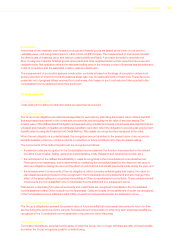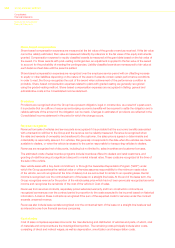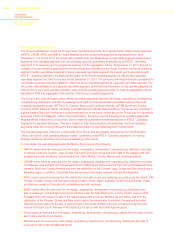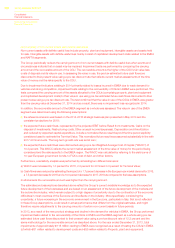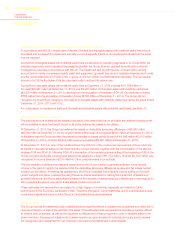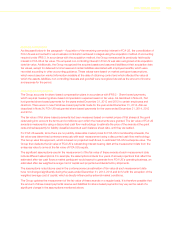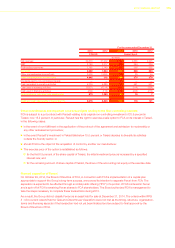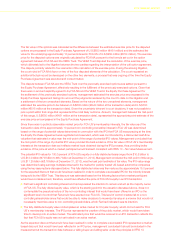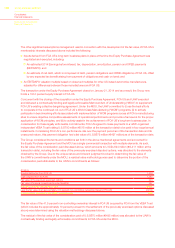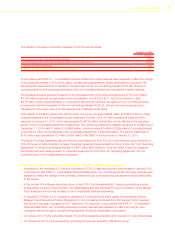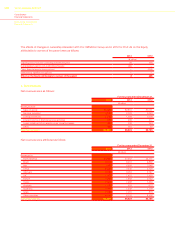Chrysler 2014 Annual Report Download - page 173
Download and view the complete annual report
Please find page 173 of the 2014 Chrysler annual report below. You can navigate through the pages in the report by either clicking on the pages listed below, or by using the keyword search tool below to find specific information within the annual report.
2014 | ANNUAL REPORT 171
The Group uses price discounts to adjust vehicle pricing in response to a number of market and product factors,
including pricing actions and incentives offered by competitors, economic conditions, the amount of excess industry
production capacity, the intensity of market competition, consumer demand for the product and the desire to support
promotional campaigns. The Group may offer a variety of sales incentive programs at any given point in time, including
cash offers to dealers and consumers and subvention programs offered to customers, or lease subsidies, which
reduce the retail customer’s monthly lease payment or cash due at the inception of the financing arrangement, or
both. Sales incentive programs are generally brand, model and region specific for a defined period of time.
Multiple factors are used in estimating the future incentive expense by vehicle line including the current incentive
programs in the market, planned promotional programs and the normal incentive escalation incurred as the model
year ages. The estimated incentive rates are reviewed monthly and changes to the planned rates are adjusted
accordingly, thus impacting revenues. As there are a multitude of inputs affecting the calculation of the estimate for
sales incentives, an increase or decrease of any of these variables could have a significant effect on revenues.
Product warranties and liabilities
The Group establishes reserves for product warranties at the time the sale is recognized. The Group issues various
types of product warranties under which the performance of products delivered is generally guaranteed for a certain
period or term. The reserve for product warranties includes the expected costs of warranty obligations imposed by
law or contract, as well as the expected costs for policy coverage, recall actions and buyback commitments. The
estimated future costs of these actions are principally based on assumptions regarding the lifetime warranty costs
of each vehicle line and each model year of that vehicle line, as well as historical claims experience for the Group’s
vehicles. In addition, the number and magnitude of additional service actions expected to be approved and policies
related to additional service actions are taken into consideration. Due to the uncertainty and potential volatility of these
estimated factors, changes in the assumptions used could materially affect the results of operations.
The Group periodically initiates voluntary service and recall actions to address various customer satisfaction and
safety and emissions issues related to vehicles sold. Included in the reserve is the estimated cost of these service and
recall actions. The estimated future costs of these actions are primarily based on historical claims experience for the
Group’s vehicles. Estimates of the future costs of these actions are inevitably imprecise due to some uncertainties,
including the number of vehicles affected by a service or recall action. It is reasonably possible that the ultimate cost
of these service and recall actions may require the Group to make expenditures in excess of (or less than) established
reserves over an extended period of time. The estimate of warranty and additional service and recall action obligations
is periodically reviewed during the year. Experience has shown that initial data for any given model year can be volatile.
The process therefore relies upon long-term historical averages until actual data is available. As actual experience
becomes available, it is used to modify the historical averages to ensure that the forecast is within the range of
likely outcomes. Resulting accruals are then compared with current spending rates to ensure that the balances are
adequate to meet expected future obligations.
Warranty costs incurred are generally recorded in the Consolidated income statement as Cost of sales. However,
depending on the specific nature of the recall, including the significance and magnitude, the Group reports certain of
these costs as Other unusual expenses. The Group believes that this separate identification allows the users of the
Consolidated financial statements to better analyze the comparative year-on-year financial performance of the Group.
In addition, the Group makes provisions for estimated product liability costs arising from property damage and
personal injuries including wrongful death, and potential exemplary or punitive damages alleged to be the result of
product defects. By nature, these costs can be infrequent, difficult to predict and have the potential to vary significantly
in amount. The valuation of the reserve is actuarially determined on an annual basis based on, among other factors,
the number of vehicles sold and product liability claims incurred. Costs associated with these provisions are recorded
in the Consolidated income statement and any subsequent adjustments are recorded in the period in which the
adjustment is determined.


